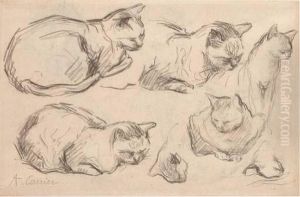Auguste-Joseph Carrier Paintings
Auguste-Joseph Carrier, born in 1800 and passing in 1876, was a French sculptor whose work falls into the Romantic period of the 19th century, a time when art was characterized by its emphasis on emotion, individualism, and the glorification of all the past and nature. While not as widely recognized as his contemporaries, Carrier's contributions to French sculpture helped to enrich the artistic landscape of his time, showcasing a dedication to both classical forms and the emerging trends of his era.
Carrier's career was marked by his adept skill in sculpting figures and busts, which he executed with a keen attention to detail and a profound sense of life and expression. He was adept in working with various materials, including marble, bronze, and plaster, demonstrating versatility and a deep understanding of each medium's unique qualities. His works often reflected the Romantic interest in expressing human emotion, historical themes, and the natural world, aligning him with the broader artistic movements of his time.
Despite the scarcity of records on his life and the overshadowing fame of other artists of the Romantic era, Carrier's sculptures remain valuable for their artistic merit and historical significance. They provide insight into the aesthetic preferences and cultural contexts of 19th-century France, serving as a testament to the era's diverse artistic endeavors. Auguste-Joseph Carrier's legacy, though not as prominent as some of his peers, underscores the richness of the Romantic movement and the varied contributions of its artists.

